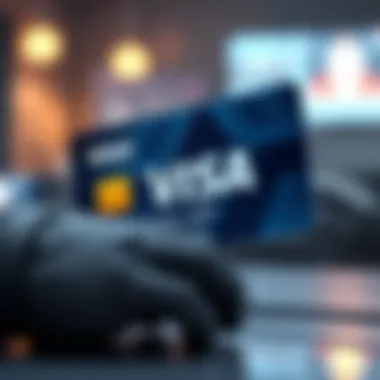Understanding Visa Direct P2P: Applications and Impact


Intro
The landscape of digital payments is evolving at an impressive pace, and at the center of this transformation is the notion of peer-to-peer (P2P) transactions. Visa Direct P2P stands out as a seemingly simple yet remarkably effective way to facilitate swift and secure financial exchanges. As technology reshapes how we interact with money, understanding the implications and applications of solutions like Visa Direct P2P can illuminate the path forward.
Visa Direct enables users to send funds directly to each other using nothing more than a Visa card, which may sound straightforward. However, beneath the surface, the innovation speaks volumes about security, efficiency, and the integration of traditional payment methods into the realm of cryptocurrency and digital currencies. This article delves into the nitty-gritty of Visa Direct P2P, shining a light on its operational mechanics and its wider relevance in today's financial ecosystem.
To appreciate how this technology fits into the broader picture, let's first outline some key concepts that underpin cryptocurrency as a whole. By doing so, we will create a framework within which Visa Direct P2P can be accurately assessed and understood.
Prelude to Visa Direct P2P
Visa Direct P2P presents a compelling entry point into the modern payment landscape, representing how transaction methodologies are evolving. With rapid globalization and an ever-increasing need for swift financial transactions, understanding Visa Direct and its peer-to-peer payment capabilities is crucial. This understanding goes beyond mere knowledge; it taps into the convenience, security, and agility that the digital age demands from financial solutions.
It is paramount to acknowledge some key elements surrounding Visa Direct. First, it operates as a bridge, linking consumers and businesses, allowing for seamless transactions at the click of a button. Second, the platform's unique ability to facilitate real-time payments offers significant advantages to users—whether transferring money between friends or paying a service provider. Not to be overlooked is third, the integration of robust security protocols designed to safeguard users’ financial data, making transactions not only swift but also secure.
Moreover, this P2P system reshapes how individuals manage their finances, offering more flexibility with their funds. In an age where immediacy often dictates consumer behavior, the appeal of Visa Direct becomes all the more relevant. The intersection it creates between traditional banking infrastructure and modern-day requirements is noteworthy for investors, traders, and developers alike.
As we journey further into this article, we’ll unpack how Visa Direct operates and its broader implications within the financial ecosystem, especially in regard to emerging technologies like cryptocurrency.
"In today's fast-paced environment, the speed of transactions directly influences consumer satisfaction and operational efficiency."
Overview of Visa Direct
Visa Direct allows users to initiate transactions directly from their bank accounts, effectively bypassing traditional banking bottlenecks. The strength of the Visa network lies in its established reach, making it accessible to a global audience. By offering a reliable payment mechanism, Visa Direct effectively supports both domestic and international transactions, further highlighting its versatility.
What is a P2P Payment System?
P2P, or peer-to-peer, payment systems enable individuals to send and receive money directly between their bank accounts or digital wallets without the need for intermediaries. Essentially, this technology removes the middleman, leading to quicker and often less expensive transactions. It’s an approach that aligns perfectly with the expectation of prompt service that modern consumers demand.
Moreover, what distinguishes P2P systems is their user-friendly interfaces, enabling people of varying technological expertise to navigate and use them with ease. Transactions typically occur only a few clicks away—something that elevates user experience significantly. By leveraging mobile technology, these systems also facilitate on-the-go transactions, giving users an unprecedented level of control over their financial activities.
Ultimately, the emergence of Visa Direct and similar solutions illustrates the shift towards a more digital-native financial environment, where the power dynamically shifts toward the consumer.
The Mechanics of Visa Direct P2P
Understanding how Visa Direct P2P operates is crucial for grasping its role in the financial ecosystem. This section covers the inner workings of the platform, shedding light on the technical aspects that make it both efficient and secure. With the surge in digital payments, knowing the mechanics behind Visa Direct P2P can provide valuable insights into its operations and potential benefits for users and institutions alike.
Data Transmission and Security Features
Data transmission within Visa Direct P2P is designed with robust security protocols. The use of end-to-end encryption ensures that sensitive information remains confidential as it traverses networks. Visa employs advanced security measures like tokenization to protect personal data, which means that account numbers are not transmitted during transactions. Instead, a unique token is used.
Moreover, Visa's infrastructure adheres to stringent PCI DSS (Payment Card Industry Data Security Standard) requirements. This certification underscores Visa's commitment to safeguarding transactions and building trust among users. An essential point here is real-time monitoring of transactions, which aids in detecting fraudulent activities promptly, further enhancing security.
"In the realm of digital payments, a sound security framework is not just a feature; it's a prerequisite for success."
Users can be confident that their transactions with Visa Direct P2P are protected against unauthorized access and data breaches, making this payment solution appealing for everyday use. The security protocols employed are not merely a box-ticking exercise; they are integral to the platform's overall reliability and user trust.
Transaction Processing Flow
The transaction processing flow in Visa Direct P2P is streamlined to enhance user experience. When a peer initiates a transaction, the request is routed through Visa's secure network. Here's a simplified overview of the flow:
- Initiation: A user starts the transaction using a mobile app or website linked to Visa Direct.
- Validation: The system verifies the sender’s information, checking not only for account validity but also for sufficient balance.
- Authorization: After successful validation, an authorization request is sent to the relevant issuing bank, which either approves or declines the transaction.
- Settlement: Upon approval, funds are settled almost instantly, reflecting in both sender's and recipient's accounts.
This efficient transaction flow means that funds can be transferred at remarkable speed, offering real-time processing that appeals to consumers and businesses alike. In this fast-paced digital world, the ability to complete transactions quickly can be a defining characteristic of any payment processing system.
Integration with Financial Institutions
Visa Direct P2P doesn't operate in a vacuum; it is intricately linked with a network of financial institutions. This integration is vital. Banks and credit unions play a critical role in facilitating these transactions. They act as gateways, enabling seamless fund transfers between accounts.


Moreover, the collaborative effort between Visa and financial institutions fosters an environment where services can be tailored to meet the needs of diverse users. For instance:
- Enhanced Accessibility: Users can access funds through multiple channels – ATMs, online banking, or mobile apps, thus widening the reach of Visa Direct.
- Localized Services: Financial institutions can offer Visa Direct P2P tailored to local preferences and compliance regulations, easing adoption worldwide.
In practical terms, this integration enhances consumer confidence as users can trust that established institutions are part of the payment network. Trust is crucial in the financial domain, and knowing that a respected bank is involved can significantly ease user apprehension regarding digital transactions.
Benefits of Visa Direct P2P
Visa Direct P2P offers a transformative approach to payments, playing a crucial role in the evolving landscape of financial transactions. As peer-to-peer payment systems gain traction, understanding the specific advantages of Visa Direct is paramount for various stakeholders, ranging from investors to educators. Each benefit of this platform illuminates its importance, giving insight into how it can redefine money transfer processes.
Speed and Efficiency
One of the standout attributes of Visa Direct P2P is its impressive speed. Unlike traditional banking methods, which might take several hours or even days to process transactions, Visa Direct completes transfers in real-time. This immediacy is particularly valuable for users needing prompt fund availability.
Imagine sending money to a friend for a shared dinner. With Visa Direct, the funds travel almost instantaneously, allowing for immediate access. This feature significantly enhances user experience, making financial transactions as seamless as sending a text. It’s almost like flicking a switch—money goes in and out without the usual waiting games.
The immediacy of Visa Direct not only caters to individual needs but also supports businesses demanding quick cash flow.
Additionally, the efficiency extends beyond speed. The system operates on Visa’s expansive network, known for robust infrastructure and reliability. This quality ensures fewer transaction failures and minimizes the potential for errors, which can plague alternative methods.
Cost-Effectiveness Compared to Traditional Methods
When weighing the financial implications of using Visa Direct, cost-effectiveness stands out. Traditional methods of transferring money, like wire transfers or checks, often come with substantial fees. Visa Direct, in contrast, typically imposes lower transaction charges, appealing to cost-conscious users.
For small businesses or freelancers, the savings can be quite significant. Instead of losing a chunk of earnings to fees, users can retain more of their income, which, over time, adds up. It’s a win-win situation—money moves quickly and at a lower cost, enhancing overall financial efficiency.
Moreover, Visa Direct allows for different pricing models, enabling users to choose based on their needs. This flexibility ensures that whether you're a casual user sending lunch money or a business handling payroll, there's a cost-efficient option available.
User Convenience and Availability
User convenience is a fundamental pillar of Visa Direct P2P. The system is designed with the end-user in mind, offering a user-friendly interface that simplifies the process of sending and receiving money. Many users find the experience intuitive, whether through a mobile app or a web interface.
Furthermore, Visa Direct is widely accepted across multiple platforms. Users can connect it to various digital wallets, such as PayPal or Venmo, thereby expanding its utility. This cross-platform functionality means that users are not locked into one system, providing a convenient way to manage their finances without juggling multiple apps.
Availability is another key advantage. Visa's global reach means that transactions can often be conducted internationally with minimal fuss. Users can send money across borders easily, swapping currency without cumbersome processes. For a global economy increasingly reliant on swift cross-border transactions, this accessibility is invaluable.
Visa Direct P2P in the Cryptocurrency Landscape
The intersection of Visa Direct P2P and the realm of cryptocurrency presents an exciting frontier for both financial transactions and digital innovation. As cryptocurrencies continue to gain traction in global finance, the application of Visa Direct P2P becomes increasingly relevant, bridging traditional financial infrastructures with the decentralized ethos of the crypto world. Understanding how Visa Direct integrates into this landscape is critical for investors, developers, and analysts alike, as it outlines potential opportunities and considerations for future transactions.
Facilitating Crypto Transactions
The need for streamlined and efficient systems in facilitating crypto transactions cannot be overstated. Visa Direct P2P addresses this demand by enabling instantaneous transfers that significantly reduce the friction often associated with cryptocurrency transactions. Traditionally, crypto transactions can be bogged down by longer processing times and complex compliance requirements. Visa Direct simplifies this by offering a rapid settlement framework, which allows cryptocurrency holders to convert their assets into fiat currencies seamlessly.
Moreover, this system allows for direct payments without the need for intermediaries, mitigating issues related to transaction costs and delays. An investor can send or receive cryptocurrency using their Visa Direct-enabled wallets with ease, which is crucial in markets that demand speed and reliability.
Cross-Border Transactions and Currency Conversion
Cross-border transactions have always been a point of contention in traditional finance. Currency conversion fees, exchange rates, and lengthy settlement periods create barriers for individuals and businesses alike. Visa Direct P2P plays a pivotal role in enhancing cross-border payments by executing transactions in real-time. This capability not only reduces costs but also improves transparency, as users can view exchange rates and conversion fees upfront.
Consider a scenario where a trader in the United States wants to send Bitcoin to a supplier in Europe. With Visa Direct’s ability to facilitate these transactions, the entire process becomes more straightforward. The supplier can receive Euros instantly, benefitting from favorable exchange rates, while avoiding complex foreign currency regulations.
"Visa Direct empowers users to engage in crypto transactions that were previously considered cumbersome or unfeasible."
Integration with Digital Wallets
As digital wallets become increasingly prevalent in the financial ecosystem, the integration of Visa Direct P2P with these wallets opens new avenues for users. Individuals can manage their cryptocurrency and fiat currencies in one place, enhancing their overall experience. Applications such as Coinbase and BitPay have recognized the importance of this integration, creating seamless pathways for users to transact using the Visa ecosystem.


Additionally, this integration provides users with access to Visa’s robust security features, which can significantly increase trust in digital wallet solutions. By tapping into Visa’s established network, digital wallets can offer enhanced fraud detection measures and improved user verification, making them safer for consumers with their growing financial aspirations.
Challenges and Limitations
In the world of digital payments, navigating the landscape of Visa Direct P2P presents its own set of challenges and limitations. Understanding these hurdles is crucial for both users and developers. Here, we break down the pressing challenges that need consideration to provide a clearer picture of what lies ahead for this payment solution.
Regulatory and Compliance Issues
One of the primary challenges facing Visa Direct P2P involves navigating a spider's web of regulations. As financial transactions cross borders, they often become subject to differing regulations, depending on the jurisdiction. Laws regarding anti-money laundering (AML) and know your customer (KYC) practices can complicate the processing of transactions.
Financial institutions are often required to comply with stringent rules, making it important to have robust compliance protocols in place.
- Global Variability: Different countries have different laws governing digital payments.
- Impact on User Access: Regulatory constraints could restrict access to certain users, particularly in regions with tighter controls.
Implementing these regulatory requirements can be time-consuming and costly, which ultimately affects the speed and efficiency that Visa Direct P2P aims to offer.
Security Vulnerabilities and Risks
With the rising tide of digital payment solutions comes a corresponding increase in security concerns. Visa Direct P2P, while built upon Visa's secure network, is still vulnerable to various security threats like phishing attacks and data breaches.
The key risks include:
- Fraudulent Transactions: Users might become victims if their information is compromised.
- Data Integrity Issues: Ensuring the accuracy and authenticity of transaction data is crucial.
These vulnerabilities highlight the need for ongoing investment in security mechanisms. Furthermore, the adoption of advanced technologies, such as AI and machine learning, to detect suspicious behaviors can be beneficial in mitigating risks. However, this requires continual adaptation and investment, which may pose challenges for smaller financial institutions.
Market Adoption Hurdles
Even with its technological advantages, the journey toward broad market adoption of Visa Direct P2P is fraught with obstacles. Users often exhibit a certain level of hesitance in adopting new financial technologies. This skepticism may arise from various sources:
- Familiarity and Comfort: Many users prefer traditional payment methods they are accustomed to.
- Education and Awareness: There's a learning curve involved in understanding how new payment solutions operate and their benefits.
To successfully broaden its reach, stakeholders need proactive engagement to build trust and confidence. This could involve:
- Educational campaigns to explain benefits and functionalities.
- Collaborations with trusted brands to reinforce credibility.
Ultimately, addressing these challenges is essential for Visa Direct P2P to thrive in a competitive payment landscape.
The understanding of challenges and constraints can pave the way for innovations that might overcome them.
In dealing with these issues, not only can we enhance the user experience, but we can also offer a safer and more convenient payment solution for everyone involved.
Comparative Analysis with Other Payment Solutions
In an ever-evolving financial landscape, it’s pivotal to understand how different payment systems function in relation to one another. The analysis of Visa Direct P2P in comparison to other payment methods like PayPal and blockchain payments sheds light on its unique benefits and potential limitations. Each system has its own strengths, and understanding these can guide users in making informed choices.
Visa Direct vs. PayPal
When pitting Visa Direct against PayPal, one cannot overlook the fundamental difference in their operating models. Visa Direct functions as a real-time payments network, directly linked to Visa's extensive banking partnerships. This allows users to send and receive money promptly.
On the contrary, PayPal represents a more traditional platform, processing transactions but often involving longer wait times for fund availability. Here are some specific comparisons:
- Transaction Speed:
- Fees Varied:
- User Interface:
- Visa Direct typically boasts faster transactions, often completing them instantly or within a few hours.
- PayPal can take longer, especially for bank transfers, which might take several days.
- Visa Direct fees can be competitive, depending on the financial institution.
- PayPal charges a percentage on transactions, which can add up, especially in business settings.


- Visa Direct often integrates seamlessly with various banking apps, allowing users to manage payments from platforms they already trust.
- PayPal, while robust, can come with a steeper learning curve for new users, particularly in its business service facets.
In summary, while PayPal provides familiar functionalities, Visa Direct seems to offer greater speed and efficiency, particularly for urgent transactions. For businesses and individuals focused on immediate money movement, Visa Direct stands out.
Visa Direct vs. Blockchain Payments
Blockchain technology has surfaced as a disruptive force in the payments sector, offering various advantages for peer-to-peer transactions. Comparing Visa Direct with blockchain payments reveals a few juxtaposed considerations:
- Settlement Timing:
- Security and Transparency:
- Accessibility and Adoption Rate:
- While Visa Direct transactions can be rapid, blockchain payments may require verification processes that can delay settlement, though this varies with the blockchain used.
- Blockchain offers a decentralized ledger, which enhances transparency. Users can verify transactions independently, which appeals to a tech-savvy demographic.
- Visa Direct relies on centralized systems, which might seem riskier to some; however, it has robust fraud protection measures in place that benefit users.
- Visa Direct is accessible to users worldwide who possess a Visa card, boasting high adoption rates in traditional finance.
- Blockchain, while growing, still faces hurdles in general public acceptance and understanding.
From a purely functional standpoint, Visa Direct is tailored to those needing reliable and swift transactions backed by financial institutions. In contrast, blockchain appeals to a niche group focused on privacy and the potential for decentralized finance.
"The foundation of any payment solution lies not just in its technology, but also in how it addresses the real-world needs of users."
Future Prospects of Visa Direct P2P
The landscape of financial transactions is evolving, and Visa Direct P2P is positioned to play a pivotal role in this transformation. Understanding the future prospects of Visa Direct P2P means recognizing its impact not only on current payment methods but also on the overall financial ecosystem. As the demand for faster, more secure, and user-friendly payment solutions grows, Visa Direct P2P stands at the forefront, offering numerous benefits and addressing key considerations for users, businesses, and regulators alike.
Technological Innovations on the Horizon
Innovation is the lifeblood of any financial service, and Visa Direct P2P is no exception. Several technological advancements are on the edge of revolutionizing how this payment system operates. One of the most promising areas is the incorporation of artificial intelligence and machine learning into transaction processing. These technologies could enhance fraud detection mechanisms, ensuring that transactions remain secure while minimizing false positives that often cause inconvenience to users.
Moreover, the integration of blockchain technology holds potential for increased transparency and traceability of transactions. As the world continues to embrace digital currencies, Visa Direct P2P could leverage blockchain to facilitate rapid payments that are not only secure but also cheap. This could drive efficiency further in cross-border transactions, which have often been hampered by high fees and slow processing times.
"The future is not about choosing between technology and security, but rather blending them seamlessly to create a robust payment ecosystem."
As these technologies advance, users will likely see improvements in transaction speed and reliability, making Visa Direct P2P an even more attractive option for both personal and commercial use.
Potential Market Growth and New Opportunities
The market for peer-to-peer payment solutions is expanding rapidly. Research indicates that more consumers are becoming comfortable with digital payment methods, providing a fertile ground for Visa Direct P2P to flourish. According to industry analysts, the P2P payments market is expected to reach considerable heights in the coming years due to increasing smartphone penetration and digital wallet adoption.
A significant opportunity for Visa Direct P2P lies in emerging markets. In regions where traditional banking services are limited, peer-to-peer solutions can help bridge the gap, allowing users to transact conveniently. For example, as mobile service providers and financial institutions expand their services in parts of Africa and Southeast Asia, there is a tangible opportunity for Visa Direct P2P to establish itself as a leading payment solution.
Furthermore, collaborations with businesses and fintech startups can unlock new service offerings. Companies might explore loyalty programs, adaptive payment solutions or even peer-based lending options, which could directly integrate with Visa Direct's framework. As diverse groups adopt these technologies, companies would benefit from strategic partnerships that drive growth and market presence.
Ending
This article has explored the intricacies of Visa Direct P2P, revealing its significant role in reshaping peer-to-peer transactions within the modern financial landscape. Understanding this payment solution is crucial for a variety of stakeholders, from everyday consumers transferring funds to major entities seeking speedy, secure transaction methods.
Summary of Key Insights
Visa Direct P2P offers several key advantages that set it apart from traditional payment methods. These include:
- Swift Transactions: Transfers can occur nearly instantly, a major improvement over older methods that often delay access to funds.
- Enhanced Security Measures: Visa's established infrastructure offers enhanced security features, ensuring that both sender and recipient can trust the system.
- User-Friendly Interface: The integration with existing financial institutions simplifies transactions for users who may not be technologically savvy.
Moreover, the system's potential applications stretch far beyond simple person-to-person payments. With the rise of cryptocurrencies and digital wallets, Visa Direct P2P stands at the intersection of fiat and digital currencies, facilitating greater fluidity in how money moves across platforms.
"Visa Direct P2P is not merely a transactional tool; it's a bridge connecting diverse financial ecosystems, paving the way for more integrated financial experiences."
Implications for Future Transactions
The continued evolution of Visa Direct P2P is poised to have significant implications for the future of financial transactions. As digital wallets and cryptocurrencies gain traction, the integration of a reliable, fast, and secure payment system becomes paramount. Some potential implications include:
- Greater Accessibility: Facilitating access to financial services for underbanked populations, bridging gaps in traditional banking infrastructures.
- Business Opportunities: For developers and analysts, the chance to innovate on top of this platform means more service offerings, tailored to specific consumer needs.
- Evolution of Regulations: As use increases, regulatory bodies will likely adapt laws, creating a framework around these transactions that could both hinder and promote growth.
In summary, understanding Visa Direct P2P today is not just about grasping its current functionalities. It’s about recognizing its potential to catalyze significant shifts in financial transactions tomorrow.







